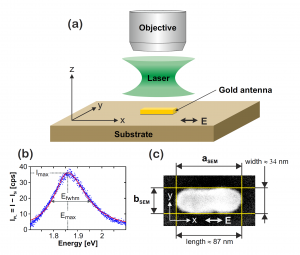We used a confocal laser microscope to investigate the one-photon photoluminescence (PL) of gold antennas. The PL spectra can precisely be fitted to a plasmon enhanced photoluminescence model. For increasing antenna length, the energy peak position decreases continuously until it reaches a value of 1.7 – 1.8 eV. For longer antennas and smaller plasmon energies, we observe an additional, persistent shoulder in the PL spectra, which we explain by a Gaussian-shaped peak at ~1.78 – 1.79 eV. We attribute this behavior to the opening of an additional decay path for electrons at the gold interband transition edge which we observe only for long antennas.
|
|
(a) Schematics of the PL measurements. (b) PL spectrum and its Lorentzian fit as an example. Here, the power P of the incident laser was 500 mW. (c) SEM image of the corresponding gold antenna whose geometrical values (length aSEM and width bSEM) are determined as indicated by the yellow lines. |
Additional peak appearing in the one-photon luminescence of single gold nanorods
Toni Froehlich, Christian Schönenberger, and Michel Calame
Optics Letters 41(7) 1325-1328 (2016)
